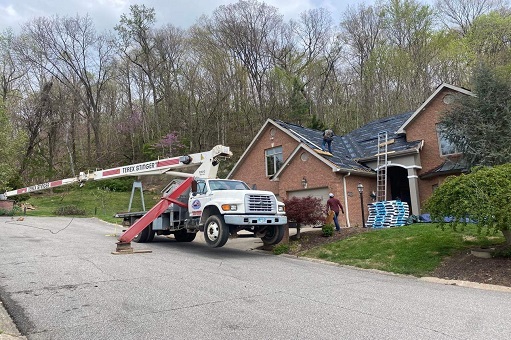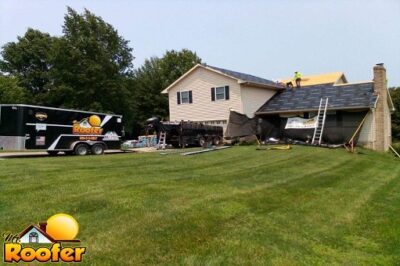Installing shingles on a roof is a crucial task that requires careful planning and execution. Whether you’re a seasoned DIY enthusiast or a beginner looking to learn, this step-by-step guide will walk you through installing shingles on your roof.
Shingles are a popular roofing material known for their durability, aesthetic appeal, and ease of installation. So, let’s dive in and learn how to install shingles like a pro!
Step 1: Prepare the Roof Deck
Before installing shingles, ensuring that your roof deck is in optimal condition is crucial. Remove existing roofing materials, such as old shingles or tiles, and thoroughly clean the deck to eliminate debris and dirt.
Check the deck for any signs of damage, such as rot or weakened areas, and make any necessary repairs to ensure the roof’s structural integrity.
A sturdy and well-prepared deck will provide a solid foundation for the shingles and contribute to the overall longevity of your roof.
Step 2: Install the Underlayment
Underlayment is essential to protect your roof from moisture and provide an additional insulation layer.
Typically, an asphalt-saturated felt is used as an underlayment material. Commencing at the bottom of the roof, roll out the underlayment horizontally, ensuring it overlaps each row by a few inches.
Secure the underlayment with roofing nails or staples, ensuring it lies flat and taut. This underlayment is a moisture barrier, preventing water from seeping through the shingles and damaging the roof structure.
Step 3: Start Shingling at the Eaves
With the underlayment, it’s time to start laying the shingles. Begin at the roof’s eaves, the lower edge where the roof meets the walls. Starting with a starter strip is recommended to ensure proper water shedding.
The starter strip consists of shingles without tabs, providing a solid base for the first row of shingles.
Secure the starter strip with roofing nails or staples, following the manufacturer’s guidelines regarding the placement and spacing of fasteners.
Step 4: Lay the Shingles
Now, it’s time to lay the shingles. Place the first shingle above the starter strip, aligning it with the eaves and ensuring it slightly overhangs the roof’s edge. This overhang allows for proper water drainage.
To ensure proper attachment, secure the shingle with roofing nails, driving the nails within the designated nailing area.
Each shingle should have good nails to prevent it from lifting or becoming loose in high winds or harsh weather conditions.
Step 5: Continue Shingling
Continue laying shingles row by row, working your way up the roof. Each subsequent row should overlap the row below it, typically by about 5-6 inches, depending on the specific shingle manufacturer’s recommendations.
This overlapping pattern creates a water-resistant barrier, directing water down the roof rather than allowing it to seep between the shingles.
Stagger the joints between shingles in adjacent rows to enhance the roof’s structural integrity, minimizing the risk of leaks and improving overall stability.
Step 6: Install Ridge Shingles
Once you’ve reached the top of the roof, it’s time to install ridge shingles. Ridge shingles are specially designed shingles that cover the roof’s peak, providing a finished appearance and additional protection against the elements.
Alternatively, you can cut regular shingles to fit the ridge line. Apply roofing adhesive or use nails to secure the ridge shingles, ensuring they overlap and interlock correctly. This step adds aesthetic value to your roof and prevents water penetration along the ridge.
Step 7: Trim Excess Material
After installing all the shingles, excess material may extend beyond the roof’s edges. Use a utility knife or roofing shears to trim the excess shingle material carefully.
Take your time and be cautious while cutting to maintain a neat and professional appearance.
Properly trimmed shingles contribute to the overall visual appeal of the roof while ensuring no loose or protruding edges that could be susceptible to wind damage.
Conclusion
Installing shingles on your roof is a rewarding endeavour that adds beauty, protection, and longevity to your home.
By following this step-by-step guide, you can confidently tackle the installation process. Remember, a well-prepared roof deck sets the stage for a successful installation.
Installing the underlayment provides an essential moisture barrier, preventing water damage and extending the lifespan of your roof. Starting at the eaves with a starter strip ensures proper water shedding.
Playing the shingles row by row, overlapping and staggering the joints, creates a durable and water-resistant barrier. Installing ridge shingles adds the finishing touch to your roof’s appearance while providing added protection.
Lastly, trimming any excess material ensures a clean and polished look. As you embark on your shingle installation journey, prioritize safety, carefully follow manufacturer guidelines, and consult professionals if needed. With patience, attention to detail, and a systematic approach, you’ll have a stunning roof that will withstand the test of time.
About Mr Roofer
Mr Roofer is a reputable roofing company with years of experience in the industry. Our team of experienced professionals is devoted to delivering high-quality roofing solutions to residential and commercial clients.
We specialize in shingle installation, repair, and maintenance, ensuring your roof remains in top condition. With our expertise, attention to detail, and responsibility for customer satisfaction, we strive to exceed your expectations and provide you with a functional roof that enhances your property’s beauty.
Trust Mr Roofer for all your roofing needs and enjoy peace of mind knowing that your roof is in capable hands.
How to Install Roofing Insulation?
Measure and cut insulation boards to fit between the roof rafters or joists.
Secure the boards using adhesive or fasteners, ensuring a snug fit.
Fill any gaps or joints with insulation foam. Install a vapour barrier over the insulation to prevent moisture buildup.
How to Install Metal Roofing on a Flat Roof?
Clean and prepare the flat roof surface. Install a layer of insulation board, followed by a vapour barrier.
Lay the metal roofing panels, starting from one edge and overlapping them according to the manufacturer’s instructions.
Secure the panels with screws or clips. Install flashing around roof penetrations and trim the excess material.
How to Install Roofing Underlayment?
Clean the roof deck and remove any debris.
Roll out the underlayment material, starting from one edge and working your way across.
Secure it with roofing nails or staples, ensuring proper alignment and overlap between the sheets.
Trim any excess material and secure the edges
How to Lay Shingles for Beginners?
Prepare the roof deck and apply an underlayment.
Starting from the bottom edge, lay the shingles in rows, overlapping each one.
Use roofing nails to secure them, following the manufacturer’s guidelines.
Continue up the roof, staggering the joints. Install ridge shingles at the top and trim any excess material.
How to Install EPDM Roofing?
Clean the roof surface and apply an adhesive primer.
Roll out the EPDM membrane, ensuring proper alignment and avoiding wrinkles.
Use a bonding adhesive to secure the membrane in place.
Trim the excess material and install flashing around roof penetrations.
How to Install Cedar Shingles?
Prepare the roof deck and apply an underlayment.
Install the cedar shingles using roofing nails or staples starting at the eaves.
Overlap each row and secure them at the designated areas.
Trim any excess material for a clean appearance.
How to Install Polycarbonate Roofing?
Measure and cut the polycarbonate sheets to fit the roof dimensions. Pre-drill holes in the sheets and secure them to the roof frame using screws and rubber washers.
Ensure proper alignment and overlap of the sheets for water resistance.
Install ridge caps at the top for added protection.
How to Install Architectural Shingles?
Prepare the roof deck and apply an underlayment.
Install the architectural shingles from the eaves by following the manufacturer’s instructions.
Use roofing nails to secure them and stagger the joints for added durability. Finish by installing ridge shingles at the roof peak.
How to Install a Roofing Roll?
Clean and smooth the roof deck.
Unroll the roofing material from one edge to another, securing it with roofing nails or adhesive.
Ensure proper alignment and smooth out any wrinkles or bubbles.
How to Install Shingles on a Roof?
To install shingles:
Prepare the roof deck and apply an underlayment.
Begin at the eaves, overlapping each row of shingles as you work your way up.
Secure them with roofing nails in the designated areas and stagger the joints for strength.
Install ridge shingles at the roof peak.
Trim any excess material for a neat finish.







0 Comments